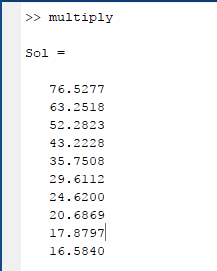
Concept explainers
Perform the same computation as in Sec. 32.1, but use
To calculate: The concentration of the distributed-parameter system equations for
Answer to Problem 1P
Solution: The concentration of equations for

Explanation of Solution
Given Information:
The distributed-parameter system depicts chemical modelling being subjected to first order decay and the tank is mixed well vertically and laterally.
Apply finite length of segment,
Here,
is the volume,
is the flow rate,
is the concentration,
is the dispersion coefficient,
is the tank’s cross-sectional area, and
is the first order decay coefficient.
Calculation:
Substitute centred finite differences for the first and the second derivatives in equation (1) to develop steady-state solution,
Further simplify the equation,
And,
Also,
Solve the equation (2),
Substitute
Hence, the required first equation is
Solve the equation (3),
Substitute
Hence, the required middle equation is
Substitute
in middle equation,
Substitute
Substitute
Substitute
Substitute
in middle equation,
Substitute
in middle equation,
Substitute
in middle equation,
Substitute
in middle equation,
Solve equation (4) for last equation,
Substitute
Hence, the required last equation is
Write all the equations in matrix form,
Express the matrix in tri-diagonal form,
Use MATLAB to solve the above matrix.
The output of the program is given below.

Want to see more full solutions like this?
Chapter 32 Solutions
Package: Numerical Methods For Engineers With 2 Semester Connect Access Card
- Algebra & Trigonometry with Analytic GeometryAlgebraISBN:9781133382119Author:SwokowskiPublisher:Cengage

 Mathematics For Machine TechnologyAdvanced MathISBN:9781337798310Author:Peterson, John.Publisher:Cengage Learning,
Mathematics For Machine TechnologyAdvanced MathISBN:9781337798310Author:Peterson, John.Publisher:Cengage Learning,  Algebra: Structure And Method, Book 1AlgebraISBN:9780395977224Author:Richard G. Brown, Mary P. Dolciani, Robert H. Sorgenfrey, William L. ColePublisher:McDougal Littell
Algebra: Structure And Method, Book 1AlgebraISBN:9780395977224Author:Richard G. Brown, Mary P. Dolciani, Robert H. Sorgenfrey, William L. ColePublisher:McDougal Littell



